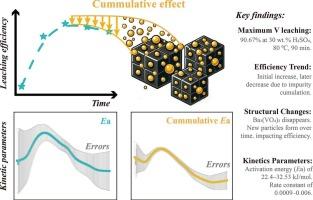Cumulative leaching behavior in sustainable vanadium extraction from V-slag using Ba-Slag
IF 5
2区 工程技术
Q1 ENGINEERING, CHEMICAL
引用次数: 0
Abstract
This study explores a sustainable “waste-to-value” approach that employs barium slag (Ba-slag), a byproduct of BaCO3 production, as a roasting additive for vanadium extraction from V-slag. Key challenges addressed include isolating a pure V product from a multi-component leachate, explaining the leaching characteristics, and managing the tailings. In this work, a roasted mixture of Ba-slag and V-slag was leached under optimized conditions, yielding a leachate from which V2O5 with 99.50 % purity was recovered via precipitation and calcination. Tailings were repurposed into foamed ceramics, achieving a maximum compressive strength of 4.05 MPa as a potential structural component. Optimal leaching parameters, 30 wt% H2SO4, 80 °C, and a holding time of 90 min, resulted in a peak V leaching efficiency of 90.67 %. The leaching efficiency increased initially but declined under excessive leaching conditions due to cumulative effects. Elemental migration, crystal phase evolution, and morphology and elemental distribution analyzes revealed that Ba3V2O8 acts as the intermediate for V concentration, with newly formed small BaSO4 particles on the tailings surface confirmed cumulative effects. Further, a novel method for calculating kinetic parameters was proposed to elucidate the cumulative characteristics. The cumulative rate constant (kd) ranged from 0.0009 to 0.006, while the activation energy (Ea) ranged from 22.4 to 32.53kJ/mol, aligning with reported values and validating the reliability of the proposed calculation method.

钒渣ba渣可持续提钒的累积浸出行为
本研究探索了一种可持续的“废物转化为价值”的方法,利用钡渣(ba -渣),一种生产BaCO3的副产品,作为从v渣中提取钒的焙烧添加剂。解决的主要挑战包括从多组分渗滤液中分离出纯V产品,解释浸出特性,以及管理尾矿。在优化的浸出条件下,将焙烧后的钡渣和钒渣混合浸出,通过沉淀和煅烧回收纯度为99.50%的V2O5。将尾矿改造成泡沫陶瓷,最大抗压强度为4.05 MPa,可作为潜在的结构组分。最佳浸出参数为30 wt% H2SO4, 80℃,保温时间90 min, V浸出效率达到90.67%。在过量浸出条件下,由于累积效应,浸出效率开始上升,但逐渐下降。元素迁移、晶相演化、形态和元素分布分析表明,Ba3V2O8是V浓度的中间产物,在尾矿表面新形成的BaSO4小颗粒证实了累积效应。此外,提出了一种计算动力学参数的新方法来解释累积特性。累积速率常数(kd)在0.0009 ~ 0.006之间,活化能(Ea)在22.4 ~ 32.53kJ/mol之间,与文献值一致,验证了所提计算方法的可靠性。
本文章由计算机程序翻译,如有差异,请以英文原文为准。
求助全文
约1分钟内获得全文
求助全文
来源期刊

Minerals Engineering
工程技术-工程:化工
CiteScore
8.70
自引率
18.80%
发文量
519
审稿时长
81 days
期刊介绍:
The purpose of the journal is to provide for the rapid publication of topical papers featuring the latest developments in the allied fields of mineral processing and extractive metallurgy. Its wide ranging coverage of research and practical (operating) topics includes physical separation methods, such as comminution, flotation concentration and dewatering, chemical methods such as bio-, hydro-, and electro-metallurgy, analytical techniques, process control, simulation and instrumentation, and mineralogical aspects of processing. Environmental issues, particularly those pertaining to sustainable development, will also be strongly covered.
 求助内容:
求助内容: 应助结果提醒方式:
应助结果提醒方式:


